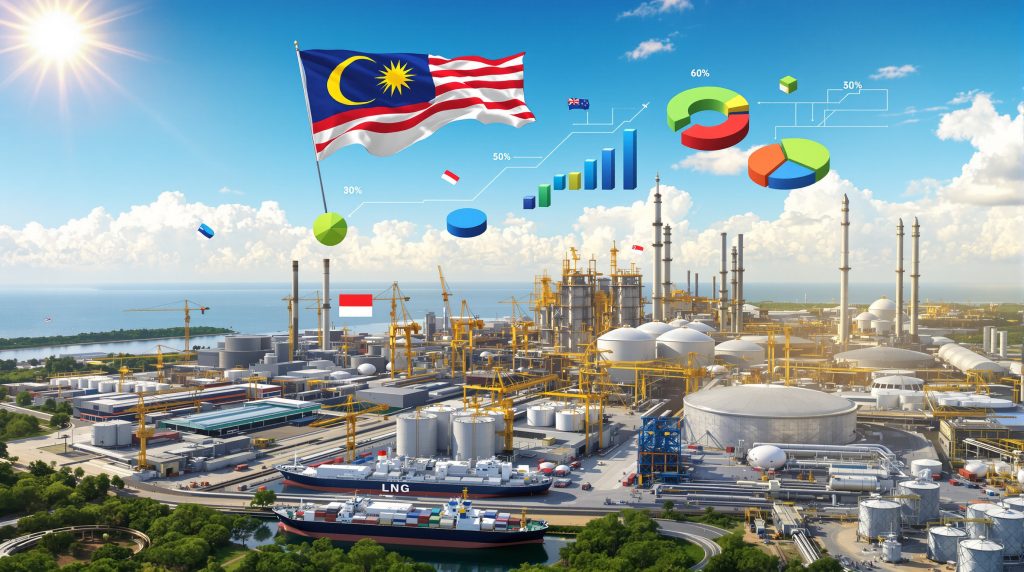Malaysia's strategic positioning in global energy markets reflects a calculated balancing act between domestic consumption and export revenues. The nation continues expanding its Malaysia coal and LNG imports despite being recognized as one of the world's largest LNG exporters. This approach demonstrates sophisticated energy portfolio management rather than contradictory policy decisions, particularly in light of ongoing coal supply challenges affecting global markets.
Coal imports reached unprecedented levels during the first half of 2024, totalling 20.9 million tons according to Reuters reporting. This surge directly correlates with Malaysia's determination to preserve domestic natural gas production for lucrative export contracts. The economic logic becomes clear when examining the power generation statistics: coal now provides 60% of Malaysia's electricity output, representing a dramatic shift from historical energy patterns.
Natural gas previously dominated Malaysia's power mix at 80% during the 2000s, but has declined sharply to just 30% in 2024 based on Ember climate advocacy data. This transformation reflects deliberate policy choices prioritising export revenue optimisation over domestic fuel preferences, aligning with global energy transition trends.
Key Import Trajectory Indicators:
- Indonesian thermal coal serves as the primary import source due to geographic proximity
- Australian coal imports have increased substantially throughout 2024
- Diversified supplier networks reduce supply chain vulnerabilities
- Import terminal infrastructure expansions support future capacity growth
The Woodside Energy agreement signed in September 2025 exemplifies Malaysia's transition toward LNG importing alongside continued exports. This 15-year contract delivers 1 million tons annually beginning in 2028, marking a strategic shift in Malaysia's energy supply architecture.
Why Is Malaysia Importing Record Amounts of Coal Despite Environmental Concerns?
The surge in Malaysia coal and LNG imports, particularly coal, stems from straightforward economic calculations rather than energy security concerns. Malaysian state energy company Petronas generates substantially higher revenues from LNG exports than the cost of importing coal for domestic power generation. This creates powerful financial incentives to substitute imported coal for domestic gas consumption.
Wood Mackenzie analysis reveals that Malaysia faces declining gas reserves coinciding with accelerating energy demand growth. Local gas production shows particularly sharp declines in peninsular Malaysia, creating supply constraints that will intensify throughout the current decade. Rather than reducing export commitments, Malaysia has chosen to increase coal imports to maintain export revenue streams.
Economic Optimisation Strategy:
- Coal import costs remain significantly below LNG export opportunity costs
- Domestic electricity generation costs stabilise through coal substitution
- Export revenue maximisation takes precedence over fuel source preferences
- Geographic proximity to Indonesian coal suppliers reduces logistics expenses
This approach creates environmental trade-offs that Malaysian policymakers acknowledge but accept as necessary for economic objectives. Furthermore, natural gas price forecasts support the economic rationale behind maintaining high-value LNG exports while importing lower-cost coal for domestic consumption.
Market Psychology Insight: Unlike other countries that have transitioned from coal to natural gas in power generation to the best of their financial abilities, Malaysia has moved in the opposite direction, demonstrating how export-oriented economies prioritise revenue generation over domestic environmental considerations.
The global LNG market context supports Malaysia's strategy. Natural gas has regained popularity after years of environmental criticism, with the European Union accepting that natural gas will remain in the energy mix indefinitely. The United States continues building new export capacity while Qatar ramps up production, creating robust demand for Malaysian LNG exports.
Paradoxically, Malaysia's coal import strategy may provide global environmental benefits by making more LNG available to other countries that would otherwise resort to coal-burning themselves. This creates complex environmental accounting where regional emissions increases could offset larger global emissions reductions.
How Are Malaysia's LNG Import Requirements Evolving?
Malaysia's transformation from purely an LNG exporter to a nation requiring strategic imports represents the natural evolution of mature energy-producing economies. Despite maintaining its position among the world's largest LNG exporters, Malaysia must now plan for growing import requirements driven by domestic demand growth and production declines.
Wood Mackenzie projects Malaysia will remain a net LNG exporter until the 2040s, but the margin between exports and domestic requirements continues narrowing. The consultancy identifies strong growth expectations in both power generation and industrial sectors, while local production faces notable declines, particularly in peninsular Malaysia where sharp production drops are anticipated from 2025 onwards.
Long-term Supply Framework:
| Supply Agreement | Volume (Annual) | Duration | Commencement |
|---|---|---|---|
| Woodside Energy (Australia) | 1 million tons | 15 years | 2028 |
| Additional suppliers under negotiation | Variable | TBD | Post-2028 |
| Regional ASEAN partnerships | Under development | TBD | TBD |
The Woodside Energy deal represents Malaysia's first major long-term LNG import commitment, signalling recognition of future supply constraints. This agreement follows extensive negotiations and reflects both parties' confidence in sustained Asian LNG demand growth.
Import Infrastructure Development:
- Receiving terminal capacity expansions to accommodate growing import volumes
- Regasification facility upgrades supporting flexible supply sources
- Pipeline connectivity enhancements for efficient domestic distribution
- Storage capacity increases providing supply security buffers
Petronas continues exploring for new domestic supply sources to minimise import dependency, but geological realities suggest limited success in offsetting production declines. The company's dual approach of domestic exploration alongside import contract negotiations demonstrates sophisticated supply portfolio management.
What Role Does Petronas Play in Malaysia's Import Strategy?
Petronas orchestrates Malaysia's complex energy import-export balance through sophisticated portfolio management that maximises national economic benefits whilst ensuring energy security. The state energy company's strategic decisions directly influence regional energy flows and Malaysia's position in global markets.
The Petronas-Woodside Energy partnership exemplifies the company's approach to long-term supply planning. This 15-year agreement demonstrates Petronas's willingness to commit to substantial import volumes whilst maintaining export growth trajectories. The timing of deliveries beginning in 2028 aligns with projected domestic supply shortfalls.
Strategic Portfolio Management:
- Supply Diversification: Securing multiple international sources reduces dependency risks
- Contract Optimisation: Balancing long-term security with pricing flexibility
- Infrastructure Investment: Expanding import capacity whilst maintaining export facilities
- Market Intelligence: Leveraging global relationships for favourable commercial terms
Petronas's dual role as both importer and exporter creates unique market positioning advantages. The company's existing LNG export operations provide deep market knowledge and established trading relationships that facilitate import negotiations. This expertise enables more sophisticated contract structures and pricing mechanisms than typical import-only companies achieve.
In addition, the company's strategic planning recognises the broader context of energy policy shifts affecting global markets and positions Malaysia to adapt accordingly.
How Do Malaysia's Energy Imports Impact Regional Market Dynamics?
Malaysia's coal and LNG import growth creates significant ripple effects throughout Southeast Asian energy markets, influencing pricing structures, supply routes, and competitive dynamics across the region. These changes extend beyond bilateral trading relationships to reshape regional energy architecture.
Regional Coal Market Transformation:
The surge in Malaysian coal imports intensifies competition for Indonesian thermal coal supplies, the region's dominant source. This increased demand pressure contributes to upward pricing trends affecting all regional importers. Enhanced logistics capacity between Indonesia and Malaysia creates infrastructure benefits that potentially serve other regional trade flows.
- Increased shipping capacity utilisation on Indonesia-Malaysia routes
- Port facility expansions supporting higher throughput volumes
- Coal quality specifications influencing regional mining operations
- Logistics cost optimisation benefiting multiple trade partnerships
LNG Market Evolution:
Malaysia's transition toward LNG importing alongside continued exports creates new market dynamics throughout Asia-Pacific. Traditional supply-demand relationships shift as established exporters become simultaneous importers, creating more complex trading patterns and pricing mechanisms.
The Woodside Energy-Petronas agreement represents broader regional integration trends where established suppliers develop bidirectional trading relationships. This evolution toward more sophisticated market structures provides greater flexibility but also creates new interdependencies.
Infrastructure Development Implications:
| Infrastructure Type | Regional Impact | Timeline |
|---|---|---|
| Import terminals | Increased regional capacity | 2025-2030 |
| Pipeline networks | Enhanced connectivity | Ongoing |
| Storage facilities | Improved supply security | 2026-2028 |
| Shipping logistics | Optimised route efficiency | Immediate |
Malaysia's approach provides a template for other maturing energy-producing nations in Southeast Asia facing similar reserve decline challenges. Indonesia, Thailand, and Vietnam monitor Malaysia's strategies as they develop their own long-term energy security planning.
What Are the Environmental and Policy Implications?
Malaysia's energy import strategy creates tension between economic objectives and environmental commitments, illustrating the complex trade-offs facing developing economies during energy transition periods. The government's policy responses attempt to balance these competing priorities through market-based mechanisms and long-term planning.
Carbon Tax Implementation Framework:
Malaysia plans carbon tax implementation targeting power utilities and heavy industries as part of transition efforts. However, the economic incentives favouring coal imports over domestic gas consumption will likely persist until LNG supply exceeds global demand, potentially extending coal dependency beyond initially anticipated timelines.
The carbon tax structure aims to internalise environmental costs whilst preserving export competitiveness. Industry observers expect the tax rates will be calibrated to influence fuel choices without severely impacting Malaysia's economic positioning in regional markets.
Long-term Environmental Planning:
- Coal phase-out timeline: Set for 2044, providing extended transition period
- Renewable energy targets: Maintained despite increased coal consumption
- Carbon emission monitoring: Enhanced tracking of power sector emissions
- International climate commitments: Balanced against economic development priorities
Importantly, the planning process considers potential decarbonisation benefits that could emerge from technological advances and market developments.
Policy Response Mechanisms:
The government acknowledges the environmental implications of increased coal consumption whilst arguing that preserved LNG exports provide global benefits by enabling other countries to avoid coal use. This environmental offset argument demonstrates sophisticated policy reasoning but faces scrutiny from climate advocacy groups.
Regulatory Challenge: Malaysia must navigate international climate commitments whilst maximising economic benefits from energy exports, creating complex policy trade-offs that require careful calibration.
Import licensing requirements undergo review to ensure adequate oversight of fuel quality and supply security. Environmental impact assessments for new facilities incorporate both local and global emission considerations, reflecting the interconnected nature of international energy markets.
How Will Future Energy Demand Growth Affect Import Requirements?
Malaysia's energy import needs will intensify as domestic demand accelerates, driven by industrial expansion, technological advancement, and economic development. Wood Mackenzie analysis indicates that energy demand growth will only accelerate in coming years, suggesting robust future demand for both coal and LNG imports.
Industrial Sector Expansion:
Manufacturing capacity increases drive electricity demand growth whilst data centre development requires reliable power supplies. The petrochemical industry expansion consumes additional gas volumes, creating multiple demand pressures on energy supply systems. These industrial developments often locate near existing energy infrastructure, intensifying regional supply requirements.
- Data centre proliferation creating consistent baseload demand
- Manufacturing diversification requiring stable electricity pricing
- Petrochemical expansion consuming significant gas feedstock volumes
- Technology sector growth demanding high reliability power supplies
Demand Scenario Analysis:
| Growth Scenario | 2030 Coal Imports (Million Tons) | 2030 LNG Imports (Million Tons) | Key Drivers |
|---|---|---|---|
| High Growth | 35-40 | 6-8 | Accelerated industrialisation |
| Moderate Growth | 25-30 | 4-6 | Steady economic expansion |
| Transition Accelerated | 15-20 | 8-10 | Renewable energy adoption |
Residential and Commercial Growth:
Urban population expansion increases energy consumption whilst economic development raises per-capita energy use. Air conditioning demand growth in Malaysia's tropical climate creates particular pressure during peak consumption periods. Commercial sector expansion requires reliable electricity supplies supporting service industry development.
Domestic gas production declines will continue regardless of exploration success, given the maturity of existing fields and geological constraints. This creates an inevitable transition toward greater import dependency that must be managed through strategic planning and infrastructure development.
What Investment Opportunities Exist in Malaysia's Energy Import Infrastructure?
Malaysia's expanding import requirements create substantial infrastructure investment opportunities across the energy supply chain. These developments span traditional energy infrastructure and advanced technology integration, offering diverse investment propositions for domestic and international capital.
Port and Terminal Development:
LNG receiving terminal expansions represent major capital investment opportunities as Malaysia prepares for growing import volumes. Existing facilities require capacity enhancements whilst new terminals may be needed to serve different geographic regions efficiently. Coal handling facility upgrades support increased throughput requirements whilst storage capacity enhancement projects provide supply security benefits.
- Regasification facility technological upgrades improving efficiency
- Floating storage and regasification units providing deployment flexibility
- Port infrastructure improvements supporting larger vessel operations
- Automated handling systems reducing operational costs
Pipeline and Distribution Networks:
Gas pipeline system extensions connect new import terminals to existing distribution networks whilst regional connectivity improvements enhance supply reliability. Smart grid integration capabilities enable more sophisticated demand management and emergency response procedures.
Technology Integration Investment Areas:
| Technology Category | Investment Focus | Expected Returns |
|---|---|---|
| Digital Monitoring | Supply chain optimisation | Operational efficiency |
| Predictive Maintenance | Infrastructure reliability | Cost reduction |
| Environmental Compliance | Automated monitoring | Regulatory adherence |
| Supply Chain Transparency | Blockchain integration | Risk management |
International energy companies seek partnership opportunities in Malaysia's evolving import infrastructure. Joint venture structures enable technology transfer whilst sharing investment risks and providing access to established market relationships.
How Does Malaysia's Import Strategy Compare Globally?
Malaysia's approach to balancing energy imports with export obligations provides insights into how resource-rich nations navigate global energy transitions. The country's strategy demonstrates sophisticated portfolio management that prioritises economic optimisation over traditional energy security concepts.
International Comparative Framework:
Similar Export-Import Balancing Nations:
- Norway: Exports oil and gas whilst importing electricity for aluminium smelting
- Australia: Exports LNG whilst importing refined petroleum products
- Qatar: Maintains domestic gas supply whilst maximising LNG exports
- Trinidad & Tobago: Balances petrochemical feedstock needs with export revenues
Malaysia's unique aspects include increasing coal imports whilst maintaining gas export growth, creating environmental trade-offs that other resource-rich nations typically avoid. The willingness to substitute coal for domestic gas consumption demonstrates exceptional commitment to export revenue maximisation.
Strategic Differentiation Factors:
Regional supply chain integration with ASEAN partners provides Malaysia advantages unavailable to geographically isolated exporters. Long-term contract strategies spanning multiple decades demonstrate confidence in sustained Asian energy demand growth that influences global market perceptions.
The dual fuel import strategy covering both coal and LNG represents more complex portfolio management than most comparable economies attempt. This approach requires sophisticated logistics coordination and market intelligence capabilities that establish competitive advantages in energy trading.
Malaysia's model demonstrates how established energy exporters can manage inevitable transitions toward import dependency whilst preserving economic benefits. The success of this strategy depends on accurate demand forecasting and infrastructure planning that supports both import and export operations simultaneously.
Investment Strategies and Market Psychology in Malaysia's Energy Transition
The evolution of Malaysia's energy import strategy reflects deeper market psychology factors that influence investment decisions and policy development. Understanding these psychological drivers provides insight into how similar economies might approach energy transition challenges.
Investor Sentiment Analysis:
Energy infrastructure investments in Malaysia benefit from government policy clarity and long-term revenue visibility. The Woodside Energy-Petronas agreement demonstrates international confidence in Malaysia's energy market stability and regulatory framework. Investors recognise that import infrastructure investments provide essential services with limited competitive pressure.
Risk Assessment Factors:
- Regulatory stability supporting long-term investment planning
- Currency stability protecting international investor returns
- Geographic advantages reducing logistics and operational risks
- Established legal frameworks facilitating contract enforcement
The apparent contradiction between environmental commitments and increased coal imports creates cognitive dissonance that Malaysian policymakers address through sophisticated economic arguments. The positioning of coal imports as enabling global LNG availability demonstrates advanced policy communication strategies.
International energy companies view Malaysia's pragmatic approach as evidence of mature energy market thinking that prioritises economic optimisation over ideological positions. This perception enhances Malaysia's attractiveness for long-term energy partnerships and technology transfer agreements.
Conclusion: Malaysia's Energy Import Evolution and Market Implications
Malaysia's strategic approach to Malaysia coal and LNG imports demonstrates sophisticated energy portfolio management that balances competing economic, environmental, and social objectives. The country's willingness to increase coal consumption whilst expanding LNG import capacity reflects pragmatic policy-making that prioritises export revenue optimisation and energy security.
Strategic Outcomes Assessment:
The dual import strategy successfully maintains Malaysia's LNG export competitiveness through domestic fuel substitution whilst creating infrastructure foundations for future energy transition phases. Diversified supply sources reduce import dependency risks whilst establishing regional leadership in flexible energy portfolio management.
Key Success Factors:
- Economic logic driving fuel substitution decisions
- Long-term contract strategies providing supply security
- Infrastructure investment timing supporting multiple scenarios
- International partnership development enhancing market access
The Malaysian model offers valuable insights for other energy-producing nations seeking to balance export revenues with domestic energy security during transition periods. As global energy markets continue evolving, Malaysia's import strategies will likely influence regional energy policies and infrastructure development across Southeast Asia.
Future Monitoring Priorities:
- Carbon tax implementation effects on import patterns and fuel choice decisions
- LNG import growth trajectory alignment with domestic demand projections
- Regional competitive responses to Malaysian import strategies and market positioning
- Infrastructure capacity utilisation rates and expansion requirement timing
The success of Malaysia's approach depends on accurate forecasting of regional energy demand growth and global LNG market development. Continued monitoring of these factors will determine whether the current strategy provides sustainable long-term benefits or requires adjustment as market conditions evolve.
Malaysia's energy import evolution represents a case study in how mature energy-producing economies can navigate complex transitions whilst preserving economic competitiveness. The lessons learned from this experience will influence energy policy development throughout Southeast Asia and other regions facing similar challenges.
Looking for Opportunities in Malaysia's Energy Infrastructure Boom?
Malaysia's strategic shift towards massive energy imports creates significant opportunities across coal and LNG infrastructure development. Discovery Alert's proprietary Discovery IQ model delivers real-time alerts on emerging mineral discoveries that support these expanding energy supply chains, helping investors identify actionable opportunities in the evolving Southeast Asian energy landscape. Begin your 30-day free trial today and position yourself ahead of the market transformation.




